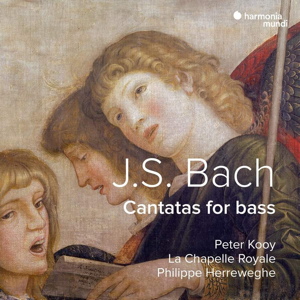
Johann Sebastian Bach (1685–1750)
Cantatas for Bass
Ich habe genug BWV 82
Ich will den Kreuzstab gerne tragen BWV 56
Der Friede sei mit dir BWV 158
Peter Kooy (bass)
La Chapelle Royale/Philippe Herreweghe
rec. 1991, Église Notre-Dame-du-Liban, Paris
Liner notes but no sung texts
Reviewed as download from press preview
HARMONIA MUNDI HMM931365 [53]
The cantatas by Johann Sebastian Bach which have been preserved number more than 200 and probably several dozen have been lost. Most of his church cantatas were composed during his first years as Thomaskantor in Leipzig, a post he took up in 1723. It was his responsibility to compose and perform a cantata every Sunday and holiday. Of these, three annual cycles of cantatas have survived. Most of them were written for four solo voices, a four-part choir and an instrumental ensemble, but there also exist solo cantatas and dialogue cantatas. Moreover, he also wrote secular cantatas for various occasions.
Record companies have found it profitable to issue Bach’s church music on LP and CD. The big works: the B-minor Mass, the St Matthew and St John Passions, the Christmas Oratorio of course, but there have also been several jumbo boxes with the complete cantatas. Single issues have also appeared regularly, and there are today available recordings for all tastes, all preferences and all price ranges; we are spoilt for choice.
The three solo cantatas for bass have frequently been coupled on disc since the arrival of CD, and earlier the two BWV 56 and BWV 82 rubbed shoulders on LP. The first of them, Ich will den Kreuzstab gerne tragen was composed in 1726 and the second, Ich habe genug, the following year. Considering the third, Der Friede sei mit dir, scholars are at a loss, since the autograph is lost and it exists only in copies made after Bach’s death. It was supposedly composed several years later than the other two, possibly in the early 1730s, and presumably there are also parts of it missing. It is much shorter than the other two; only two short recitatives surrounding a noble aria with chorale and a short chorale as conclusion – rather frustrating.
Of the three, Ich habe genug has in particular become very popular, and is, according to Wikipedia “the most frequently recorded of all the Bach cantatas over a period of more than sixty years”, with 101 complete recordings listed. There have probably been a few more since then. The young Dietrich Fischer-Dieskau recorded it in 1951 when he was 26 and returned to it twice, but Hans Hotter set it down even earlier in 1950, a version that still is among the best, at least vocally speaking. Baroque purists may object to the dated accompaniment, but as non-purist I have no problems with it. Of latter-day recordings I have a soft spot for Olaf Bär’s EMI recording of all three cantatas with the Scottish Chamber Orchestra with Peter Schreier conducting. It was made in 1991, the same year that the recording under consideration was made. As a leading Lieder singer, Bär cares a lot about the text – as of course Hotter and D-F-D also do – but Peter Kooy is just as adept, his slim, rather light voice a pliant instrument and his florid singing in Ich freue mich (tr. 5), the final aria in Ich habe genug and Endlich, endlich wird mein Joch (tr. 8), the second aria of Ich will den Kreuzstab gerne tragen is fluent. The springy rhythms in both arias are invigorating, naturally triggered by the playing of La Chapelle Royale under Philippe Herreweghe, who certainly are well versed in the historically informed performance tradition. Whether this is the authentic truth is, of course, a moot point, and since I learnt the standard baroque repertoire back in the early 1960s through recordings where Bach’s orchestral suites were played by full-size symphony orchestras, I am comfortable with the full, rounded, Romantic sounds of old-fashioned baroque playing but also accept the astringent sounds of period instruments. I have always warmed to the playing of La Chapelle Royale, and do so here too, but it seems to me that here the orchestra is balanced too close to the detriment of the voice – but this is a minor complaint – or rather a subjective response. The other arias are also deeply satisfying, but I must call attention to the lullaby Schlummert ein (tr. 3) in Ich habe genug, where no one can quite compete with Hans Hotter’s sublime reading, tender and warm. It is also remarkable how he with his huge voice, negotiates the florid singing in the final aria of the cantata. But this is just a note in passing. Peter Kooy’s reading is certainly a worthy complement. He is one of the most reliable baroque singers of the last few decades, and, like D-F-D and Klaus Mertens, returned to these cantatas. Here, though, he is at his freshest, and anyone wanting a HIP recording of these deservedly popular cantatas need search no further.
Göran Forsling
Help us financially by purchasing from




















